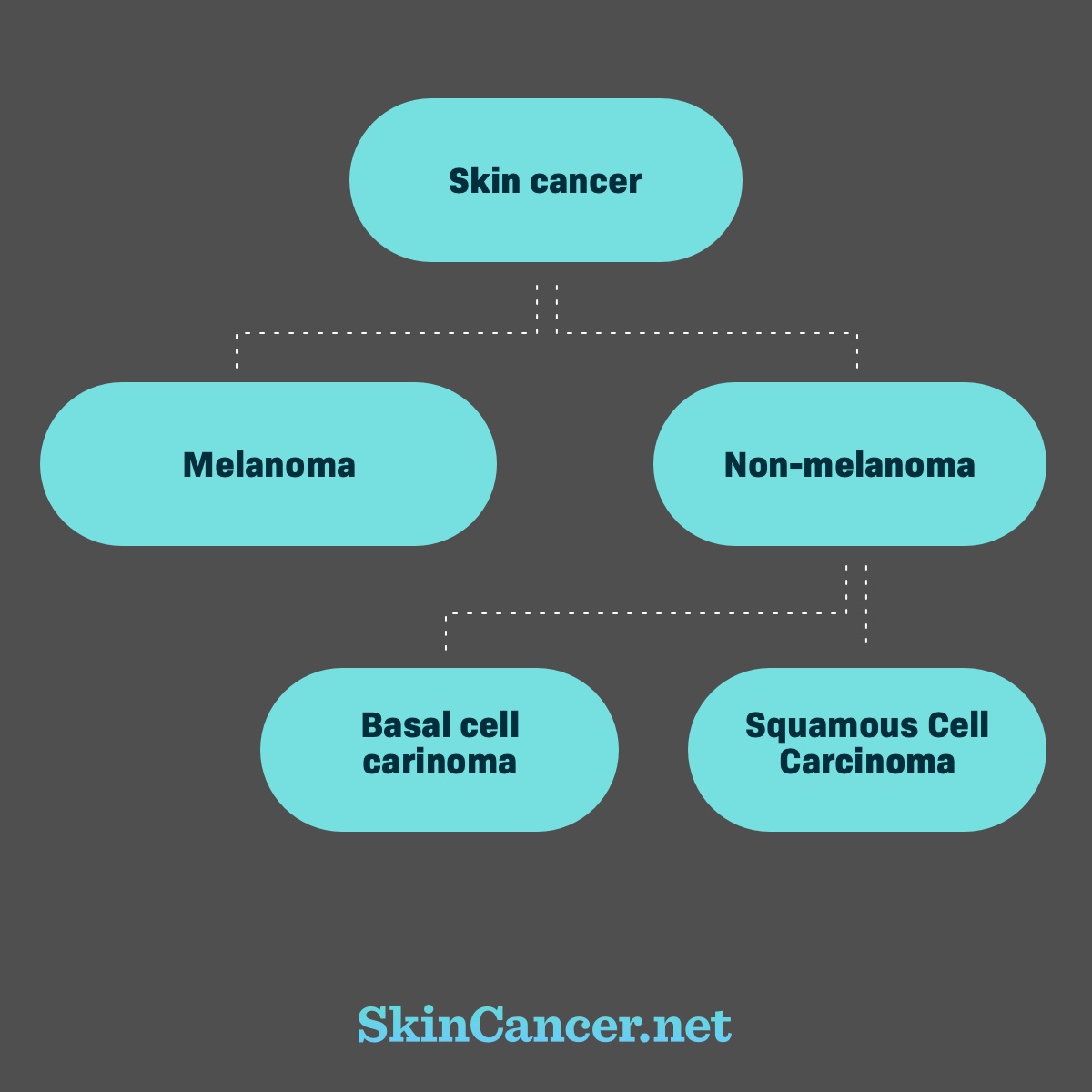Skin Cancer Types
Reviewed by: HU Medical Review Board | Last reviewed: May 2017. | Last updated: December 2022
Skin cancer is classified according to the cell type where it develops. The three main types of skin cancer are:1,2
BCC and SCC are commonly grouped together as “non-melanoma skin cancer”.
Figure 1. Classification of skin cancer
Other types of skin cancer make up less than 1% of total skin cancers. These include:2
- Merkel cell carcinoma
- Kaposi sarcoma
- Cutaneous lymphoma
- Cutaneous adnexal tumors
- Some types of sarcomas
Which type of skin cancer is most common?
BCC is the most common type. It accounts for about 80% of skin cancers.2 SCC is the second most common, making up about 20% of skin cancers.2 About 5.4 million non-melanoma skin cancers are diagnosed each year in approximately 3.3 million Americans.3
About 1% of skin cancers are melanoma.1 An estimated 87,110 new cases of melanoma will be diagnosed in 2017 in the United States.4
Which type of skin cancer is most serious?
Melanoma is more likely than non-melanoma skin cancers to invade deeper layers of skin and spread to other parts of the body (metastasize). For this reason, 75% of skin cancer deaths are related to melanoma.5
Conversely, most cases of non-melanoma skin cancer can be treated and removed, especially when they are caught early. SCC is more likely to invade deeper layers or spread within the body than BCC.2 About 5% to 10% of SCC is considered “aggressive.”2,6 Aggressive SCC is difficult to treat. In the Midwest and southern United States, SCC may cause as many deaths as melanoma.7
BCC grows very slowly. BCC is locally advanced in 0.8% of cases and metastatic in 0.04% of cases.8 Complex cases of BCC are usually related to the return of the BCC after initial treatment, which is known as recurrence.2
Treatment of any type of skin cancers can lead to scars, lost time from work, and decreased quality of life.9
What is precancer?
Actinic keratosis is a lesion that forms when cells in the top layer of skin begin to grow abnormally.10 About 6% to 10% of actinic keratoses become squamous cell carcinoma. For this reason, your doctor may recommend treating actinic keratosis.
Atypical moles are not melanoma, although they may look like melanoma. These moles are non-cancerous, but having five or more atypical moles is a strong risk factor for developing skin cancer.11,12 For this reason, your dermatologist may recommend regular screenings to keep an eye on suspicious moles.
How are the rare skin cancers different from BCC, SCC, and melanoma?
Rare skin cancers make up less than 1% of all skin cancers.2 These cancers develop in different cell types, have different risk factors, and may be treated differently than the more common skin cancers.
Merkel cell carcinoma. Merkel cells are in the top layer of skin, close to the nerve endings for the sense of touch.13Merkel cell carcinoma develops when Merkel cells begin to grow out of control. The carcinoma usually appears as a painless, dome-shaped lump on sun-exposed skin. This type of cancer grows quickly and is likely to metastasize.
Kaposi sarcoma. Malignant tumors that grow in the skin, mucous membranes, lymph nodes, and other organs characterize Kaposi sarcoma.14 The lesions look purple, red, or brown. There are different types of Kaposi sarcoma. Treatment depends on the type of Kaposi sarcoma and the patient’s general health.
Cutaneous lymphoma. Cutaneous (skin) lymphoma is a type of non-Hodgkin’s lymphoma.15 Lymphomas affect the white blood cells, called lymphocytes. Cutaneous lymphoma affects B-cells or T-cells in the skin. A typical sign of cutaneous T-cell lymphoma is red, scaly patches or thick plaques. Cutaneous T-cell lymphoma is often treatable and usually not life threatening; however, it is not curable. Cutaneous B-cell lymphoma may appear as a pimply rash, nodules, or tumors.16 Cutaneous B-cell lymphoma is slow growing and treatable.
Cutaneous adnexal tumors. This category includes a wide range of tumors that develop in structures of the skin. Skin structures include hair follicles, oil glands, and sweat glands. Some adnexal tumors are harmless (benign) and some are harmful (malignant).17
Sarcomas. Sarcomas are a kind of tumor that develops in the type of tissue found in bone or muscle (mesenchymal tissue).18 They are different from carcinomas, which are tumors that grow in the tissue that lines organs and blood vessels (epithelial tissue). Sarcomas can develop in deep skin tissue and other locations.
